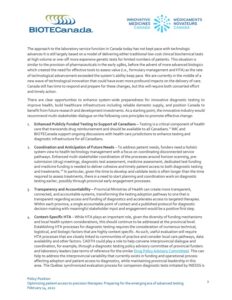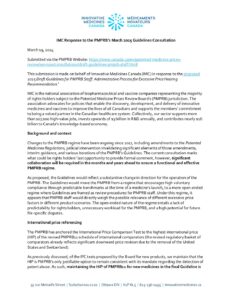
Advocacy
We represent Canada’s innovative pharmaceutical industry.
Innovative Medicines Canada is committed to being a valued partner in Canada’s healthcare system. We partner with governments, insurance companies, healthcare professionals and other stakeholders to advance our country’s life sciences sector.
The strong alliances we form support policies that improve Canada’s regulatory environment, protect intellectual property and expand Canada’s access to the newest available pharmaceuticals. We conduct all our advocacy to improve the well-being of all Canadians and protect patient safety on behalf of our members.
Partnering with government
Canada’s innovative pharmaceutical companies invest more than $2.2 billion a year to find new ways to treat and cure illnesses and diseases. Whether it’s an unprecedented response to a global pandemic, or providing life-saving treatments for cancer, heart disease, and rare disease patients, Canada’s innovative pharmaceutical sector is an important partner to help keep Canadians healthy, grow the economy, and support innovation that will solve current and future health challenges.


Our advocacy integrates the interests of federal and regional governments, ensuring all voices are represented at the policy table. The opinions we hold and the communication campaigns we use to reach healthcare stakeholders are backed by data and research conducted either by Innovative Medicines Canada or our trusted providers.
Meanwhile, Canada attracts roughly 1 percent of the world’s pharmaceutical research and development investment. We can do much better. IMC is working with industry and governments to create a regulatory environment on par with the rest of the world. Our aim is to attract substantially more foreign investment and clinical trials.
Protecting intellectual property
A globally competitive intellectual property environment is crucial for advancing innovation in any industry. Innovative Medicines Canada works diligently to protect the innovation of evidence-based pharmaceuticals by advancing the following:
- A Patent Act that provides protections and incentives similar to other developed nations – one enforced in the context of comparative international norms, such as patent utility
- Balanced patented medicines regulations that are predictable and equitable for innovators
- Data protection regulations that protect exclusivity to all innovative medicines
- Patented medicines regulations that provide the Patented Medicine Prices Review Board with a clear and limited mandate, and an updated definition to accurately calculate industry investment in Canada
In 2013, the Government of Canada took steps to improve intellectual property protection in Canada by finalizing the Comprehensive Economic and Trade Agreement (CETA). This historic agreement was an essential step in strengthening Canada’s position on the international life sciences stage.
CETA provided several key improvements for protecting intellectual property:
- Patent term restoration – This enables research-based pharmaceutical companies to recover up to two years of time lost on their patent as a result of lengthy regulatory and government approval processes. The compensation is provided through a Certificate of Supplementary Protection (CSP). The ability to receive a CSP is not absolute and is subject to a number of statutory exemptions. Canada was previously the only G7 nation that did not provide any form of patent term restoration.
- The right of appeal – The right of appeal allows research-based pharmaceutical companies to more effectively appeal court decisions where a patent is ruled invalid. The appeal process had previously been available to challengers but not patent owners.
- Patented Medicines (Notice of Compliance) Regulations – These help protect patent holders when generic companies infringe on their rights by entering the market too early. The regulations prevent generic companies from obtaining a Notice of Compliance for up to 24 months during litigation.
The renegotiation of NAFTA presented a valuable opportunity to improve Canada’s intellectual property regime. Original copies of CUSMA provided substantial improvements. However, the final text does not improve Canada’s intellectual property regime as much as it could. Originally, the agreement provided research-based pharmaceutical companies with 10 years of data protection on new biologics, but the ratified agreement removed this improvement.
Despite the lack of data protection on new biologics, CUSMA does provide an opportunity to improve Canada’s intellectual property regime in a meaningful way. Patent term adjustment (PTA) will provide additional data protection in the event that patentees experience unreasonable delays in the patent examination process. The Government of Canada has not yet amended its patent legislation to fulfill this obligation, although it must do so by January 1, 2025.
For more information on Canada’s intellectual property regime and how it compares to other jurisdictions, see the following resources:
Global Innovation Policy Centre’s 2021 International IP Index
U.S. Trade Representative 2021 Special 301 Report
Expanding Canada’s access
Increasing access to innovative medicines, vaccines and treatments for Canadian patients is central to IMC’s work. We are committed to working collaboratively with governments, industry, health care professionals and other key stakeholders to improve the pricing and reimbursement process and ensure timely access to new medicines for Canadians.
Today, Canadians with public drug plan coverage wait an average 22 months from Health Canada approval to patient access. This is two times longer than most other Organisation for Economic Co-operation and Development (OECD) countries, with Canada ranking 19 out of 20 countries that have a similar economic status.
By streamlining the access pathway, we can give Canadians faster access to the best innovations the industry has to offer – and, in doing so, achieve better health outcomes for all.

POLICY POSITIONS

IMC Response to PMPRB Interim Approach Consultation
IMC’s members continue to have significant concerns regarding changes to the PMPRB and future Guidelines that will implement the revised schedule of international reference countries.

Optimizing Patient Access to Precision Therapies: Preparing for the Emerging Era of Advanced Testing
This policy note characterizes Canada’s current testing infrastructure and its limitations, which include that it hinders current and future patient access to the best available treatments.
Government Submissions

Increasing Access to Innovative Medicines
Written Submission for the Pre-Budget Consultations in Advance of the Upcoming Federal Budget
Browse by topic
Press Releases

Pharmaceutical Industry Calls on G7 to Prioritize Innovation as Strategic Pillar for Health, Growth and Security
Geneva and Ottawa, June 12 – Ahead of the upcoming G7 Leaders’ Summit, the global pharmaceutical industry, represented by the […]

New Statistics Canada Data Reinforces Life Sciences as an Economic Engine
Innovative Pharmaceutical Industry Contributed $18.4 Billion to the Canadian Economy in 2022 Ottawa, May 12, 2024 – New data released […]

2025 Diversity and Equity in Research Award Nominations Now Open
Nominate Trailblazers in Health Equity Ottawa, May 5, 2025 – The Health Research Foundation (HRF) of Innovative Medicines Canada is […]
Analysis & Reports

The Canadian Research and Development Pharmaceutical Sector, 2022
This study examines the contribution of Canada’s research and development (R&D) pharmaceutical sector to the Canadian economy in 2022. It builds upon the annual reports produced since 2018.

Pharma 101
Use this beginner’s guide to understand the basics of how our industry works.

Newsroom
Breaking down and analyzing current events in the healthcare industry for our members, policy influencers and the Canadian public.
















